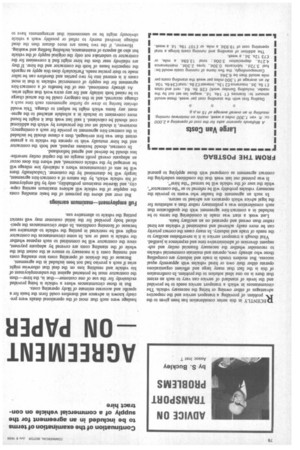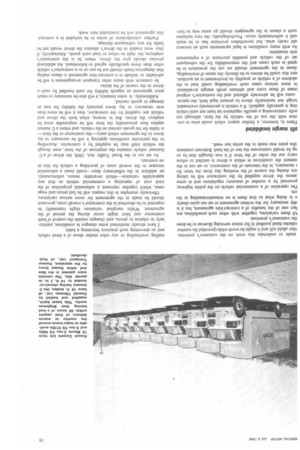AGREEMENT ON PAPER
Page 80

Page 81

If you've noticed an error in this article please click here to report it so we can fix it.
RECENTLY in this series consideration has been given to the problem of providing a transport service and the respective advantages of either owning or hiring the necessary vehicle. The circumstances in which a transport service needs to be provided and the levels of standard of service can vary to such an extent that there is no one ideal solution to the problem. In confirmation of this is the fact that many large and efficient organizations operate either their own or hired vehicles with apparently equal success. But modern trends in trade and industry are compelling those who already own, operate and maintain commercial vehicles to reconsider whether the necessary financial outlay and subsequent diversion of administrative time and experience is justified.
Vital though a transport service is it is nevertheless ancillary to the needs of trade and industry. In many cases the correct priority can be more easily achieved and maintained if vehicles are hired rather than owned and operated on an ancillary basis.
Last week a start was made in considering the terms to be included in a contract-hire agreement with the qualification that such consideration was a preliminary rather than a substitute for the legal advice which operators are advised to secure.
In such an agreement the haulier who wants to provide the necessary vehicles probably will be referred to as "the contractor", while the user of the vehicle will be termed "the hirer".
It was pointed out last week that the conditions underlying the contract agreement as compared with those applying to general haulage were such that most of the operational details were precisely known in advance and therefore could form the basis for a specific and accurate estimate of likely operating costs.
But in those circumstances where a vehicle is being provided exclusively for the use of one customer—that is, the hirer—then the contractor must be protected against the underemployment of his vehicle and resulting loss on the deal that otherwise might arise if such a proviso had not been included in the agreement.
Because of the division of operating costs into standing costs and running costs it is necessary to ensure at the outset that the whole of the standing costs are covered by adequate payment, since the contractor will be committed to such expense whether the vehicle is used or not. In some circumstances the contractor might well be restricted in putting the vehicle to alternative use because of licensing conditions. In other circumstances the specialized body provided for the initial customer may well restrict putting the vehicle to alternative use.
Full employment—maximum earnings
But over and above the payment of the basic standing costs the supplier of the vehicle will achieve maximum earning capacity, and likewise maximum profitability, only by full employment of his vehicle which, by the nature of a contract-hire agreement, largely will be determined by the customer. Undoubtedly there will be sets of circumstances where a relatively low mileage will be averaged by the vehicle concerned, and where this does occur an adequate overall profit margin on the capital outlay nevertheless should be derived and agreed beforehand.
In contrast, should business expand, and both the contractor and the hirer mutually wish to operate the vehicle to a greater extent than was first envisaged, then a clause should be included in the contract-hire agreement to provide for such a contingency; moreover, it should set out the procedure by which the additional cost should be calculated. I said last week that it might be found more convenient to include in a schedule attached to the agreement any items which might be subject to change. This would obviate having to draw up further agreements each time such a change occurred, and in this category could be the actual charge to be raised both initially and for any extra work that might arise.
As already mentioned, one of the benefits of a contract-hire agreement for the supply of commercial vehicles is that in most cases it is entered into by two parties and therefore can be tailor made to their precise needs. Particularly does this apply as regards the respective bases of both the contractor and the hirer. If they are relatively near then the hirer might find it convenient for the contractor to undertake not only the original supply of the vehicle but also all aspects of maintenance, including fuelling and washing.
However, if the two bases are more distant then the dead mileage involved merely to refuel or possibly wash a vehicle obviously might be so uneconomic that arrangements have to
p. made to undertake this work on the customer's premises. -ther afield still and it might be worth while (provided the number vehicles hired justified it) for minor servicing likewise to be done the customer's premises.
till these variations, together with other such possibilities, are fact one of the benefits of a contract-hire agreement, but it is ibly necessary for the written agreement to set out quite clearly o is doing what so that there is no misunderstanding in the are.
The operation of a commercial vehicle on the public highway governed by a number of statutory regulations and in some :ances the driver supplied by the contractor will be taking lers during the course of his working day from the hirer. So 5 necessary, in the interests of the contractor, to set out in the eement the conditions in which a driver is entitled to refuse carry out the order of the hirer if it was thought that by so ng he would contravene the law of the land. Relevant comment this point was made in the series last week.
out margin invalidated There is, however, a further aspect which could arise in conlion with the use of the vehicle by the hirer, although not actly contravening a specific regulation (at least not until vehicle ring is generally applied). If a vehicle is persistently overloaded, hough not necessarily above its present legal limit, the operatcosts will be adversely affected and the contractor's original mate of these costs and ultimate profit margin invalidated. In more serious cases such overloading could lead to the akdown of a vehicle or possibly its involvement in an accident. tere this could be shown to be directly the cause of overloading, ::lause in the agreement should set out the procedure to be 3pted in such cases and the responsibility for the subsequent air of the vehicle and possible provision of a replacement licle meantime.
As with many conditions in legal agreements such an instance uld rarely arise, but nevertheless provision has to be made auld it unfortunately occur. Psychologically, the very inclusion such a clause in the agreement should go some way to fore stalling overloading or any other similar abuse of a hired vehicle and so preventing such practices becoming a habit.
I have already mentioned some changes in conditions, particularly in relation to prices, and changes outside the control of both contractor and hirer might occur during the period of the agreement. Whilst marginal variations might reasonably be expected to be absorbed in the contractor's overall costs, provision should be made in the agreement for more serious variations.
Obviously examples in this respect will be fuel prices and wage rates, which together represent a substantial proportion of the total cost of operating a commercial vehicle so that any appreciable variation—which invariably means, unfortunately, an addition in the inflationary days—could mean a substantial increase in the overall costs of providing a vehicle for hire or on contract.
As set out in the Road Traffic Act, 1960, the driver of a Clicensed vehicle remains the employee of the hirer, even though the vehicle itself may be supplied by a contractor. According to the particular conditions applying it will be 'necessary to lay down in the agreement which party—the contractor or the hirer— is liable for the goods carried on the vehicle, and where a C-licence applies then presumably the hirer will be responsible since he employs the driver. But in reverse, when both the driver and vehicle are supplied by the contractor, then it will be more than ever necessary to lay down precisely the liability for loss or damage to goods carried.
Additionally, in some instance, it will also be necessary to reach prior agreement as regards liability for cash handled by such a driver in the course of his duties.
In common with many other transport arrangements it will be advisable to include in a contract-hire agreement a clause stating that dangerous loads should not be put on to a contractor's vehicle other than those specifically agreed to beforehand. An additional proviso should give the driver, where he is the contractor's employee, the right to refuse to load such goods. Alternatively, if they were loaded in the driver's absence the driver would not be liable for any subsequent damage.
Further consideration of terms to be included in a contracthire agreement will be concluded next week.




























































































































